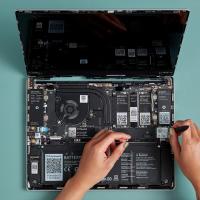The 1,000 tornadoes that tear across America’s Tornado Alley every year are notoriously difficult to detect.
When tornadoes are likely to occur, the National Weather Service monitors radar and fields resident reports in order to issue so-called tornado watches during certain kinds of storms, and warnings when a tornado has touched ground. But research shows that the majority of tornado warnings are false alarms. Even accurate warnings provide people just minutes to take shelter.
Tornadoes kill about 70 people and cause $400 million in damage every year in the U.S., mostly within Tornado Alley.
This region is in the southern central part of the nation where the majority of the world’s tornadoes occur. The threats of tornadoes are sudden, in part because we depend on human eyesight to confirm when a tornado has touched ground. But vision isn’t the only way to detect the violent vortices. Sound may be the key.
A team of scientists at the University of Mississippi’s National Center for Physical Acoustics has spent years studying how acoustic sensors can be used to “hear” tornadoes through infrasound. The technology, originally developed to detect nuclear explosions, could improve the speed and accuracy of tornado warning systems, helping to save lives and give scientists new insights into the conditions that produce the extreme phenomenon.
Listening for nuclear explosions and tornadoes
Since 1945, nations have detonated more than 2,000 nuclear bombs in atmospheric, underground, and underwater tests. Those tests came to near-complete halt in 1996 with the United Nations’ Comprehensive Nuclear-Test-Ban Treaty, which banned the detonation of nuclear weapons for any purpose. It was a small but positive step toward nuclear disarmament.
But how can the international community be sure signatories are sticking to the treaty? After all, it can be difficult to know when a nation conducts a nuclear test, especially when the bomb explodes far away from other nations. To solve the problem, nations set up hundreds of monitoring stations around the world to search for signs of nuclear explosions.
One sign is infrasound: low-frequency sound waves that occur below the range of human hearing. In the early 2000s, scientists at the National Center for Physical Acoustics helped design infrasound monitoring technology that’s been able to detect nuclear explosions from more than 6,000 miles away.
In 2011, the team turned its monitors toward a different deadly phenomenon: tornadoes.
“It was pointed out back in the [1960s] that tornadoes emit infrasound,” Roger Waxler, principal scientist at the National Center for Physical Acoustics, told Freethink. “We were skeptical. […] But we had the funding, so we dutifully went out and set out arrays of microphones in Oklahoma, and captured signals from tornadoes that were spot on.”
The arrays are able to detect tornadoes from more than 60 miles away. Each sensor consists of a battery, solar panel, domed windscreen, cabling, and a mechanism that records infrasonic signals. To date, the system has never failed to detect a tornado known to have touched ground.
Still, the NCPA and other scientists still don’t quite understand what causes tornadoes to emit infrasound.
“We are still trying to gather sufficient data to increase understanding of what causes the sound to be generated and how to ensure that what we are hearing is caused by a tornado and not just a phenomenon related to thunderstorms,” Garth Frazier, a senior research scientist at NCPA, told University of Mississippi News. “However, we are confident that the sound we have been detecting and tracking is not thunder.”
Another open question is whether the sensors are detecting tornadoes in tornado alley before they touch ground.
“There’s potentially some evidence that we do but we need more data,” Waxler told Freethink. “If there was a signal produced when the vortex forms — which we could pick up, and if it actually has a different characteristic when it actually hits the ground — that would be ideal.”
Quicker, more accurate tornado warning systems
The ability to detect tornadoes before they hit ground would provide crucial warning time for nearby people. The National Weather Service currently provides an average tornado warning time of about 9 minutes. Every additional minute could save lives, considering that tornadoes can travel at speeds of up to 60 mph.
In addition to earlier warnings, infrasound monitors could greatly improve the accuracy of tornado warnings. Today, the false-alarm rate for tornado warnings is roughly 70%. The reason isn’t necessarily that the technology is bad, but rather that meteorologists tend to err on the side of caution, sometimes issuing warnings without visually confirming a tornado.
That comes at a cost: People may start ignoring tornado warnings. While the research on this so-called false-alarm effect is mixed, a 2009 review found that tornadoes that touch down in areas with a relatively high false-alarm ratio kill and injure more people, everything else being constant.
The NCPA’s infrasound sensors have never produced a false alarm. But currently, the sensors aren’t being used to monitor for tornadoes in real time; the team leaves arrays of them in various sites and retrieves them later, using the collected data to conduct retrospective analyses.
Incorporating infrasound sensors into current tornado warning systems will take more funding, both for automating the technology and placing many sensor arrays in key sites across the most vulnerable parts of the nation. In addition to improving tornado warnings in tornado alley, the approach could provide scientists with a rich large-scale dataset on how tornadoes form and move, which could render the dangerous craft of tornado chasing obsolete.
“Tornadoes have been a horror forever,” Waxler told Freethink. “With solid funding, we could have a demonstration system that is operational, and I think the region could be covered.”
Infrasound monitoring could also someday help improve warning systems for other extreme weather phenomena, including hurricanes.
“The hurricane work — it’s less direct, it’s not tracking — but that would have a huge impact,” Waxler told Freethink.


